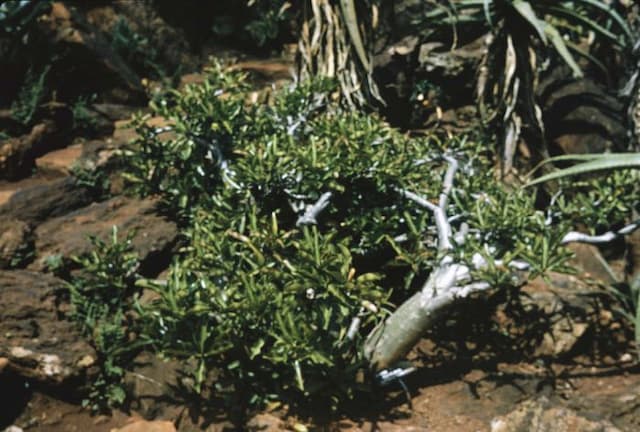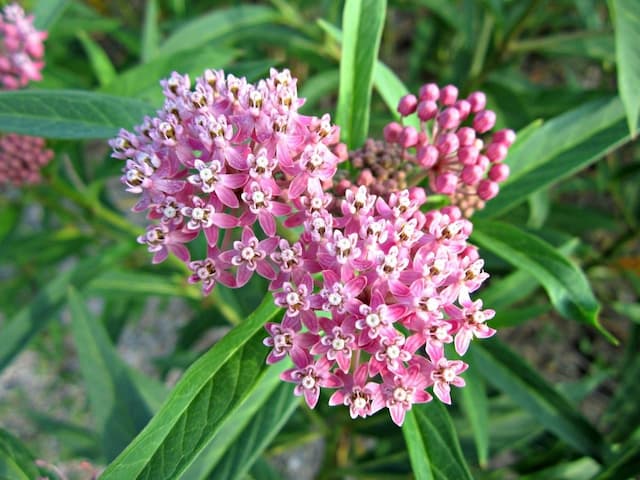Intermediate Periwinkle Vinca difformis subsp. sardoa

ABOUT
The plant commonly known as Intermediate Periwinkle is characterized by its lovely evergreen foliage that remains throughout the year. The leaves are glossy and dark green in color, lending a lush appearance to the plant. The flowers of the Intermediate Periwinkle are particularly striking, with a beautiful pale blue to violet color. They are typically star-shaped, which adds to their charming look. This plant often spreads across the ground, creating a blanket of greenery interspersed with its eye-catching flowers.
About this plant
 Names
NamesFamily
Apocynaceae
Synonyms
Intermediate Periwinkle
Common names
Vinca difformis var. sardoa.
 Toxicity
ToxicityTo humans
The plant known as Periwinkle can be toxic to humans if ingested. All parts of the plant contain alkaloids such as vincamine, which can cause poisoning. Symptoms of Periwinkle poisoning can include nausea, vomiting, diarrhea, abdominal pain, low blood pressure, depression of the central nervous system, and in severe cases, seizures, respiratory problems, and potentially coma. It is important to avoid ingesting any part of this plant.
To pets
Periwinkle can also be toxic to pets if ingested. Like in humans, all parts of the Periwinkle plant contain harmful alkaloids. Symptoms of poisoning in pets might include vomiting, diarrhea, loss of appetite, depression, incoordination, seizures, and in severe cases, potentially coma or death. Pet owners should ensure that pets do not consume any part of this plant.
 Characteristics
CharacteristicsLife cycle
Perennials
Foliage type
Evergreen
Color of leaves
Green
Flower color
Blue
Height
1-2 feet (30-60 cm)
Spread
1-2 feet (30-60 cm)
Plant type
Shrub
Hardiness zones
7
Native area
Mediterranean
Benefits
 General Benefits
General Benefits- Ornamental Value: Vinca difformis subsp. sardoa, commonly known as the Corsican periwinkle, is often grown for its attractive flowers and foliage, enhancing the aesthetic appeal of gardens and landscapes.
- Ground Cover: This plant is effective as a ground cover, reducing soil erosion and suppressing weed growth due to its dense mat-forming habit.
- Low Maintenance: Corsican periwinkle is known for being low maintenance; it requires minimal care once established, making it a convenient choice for gardeners of all skill levels.
- Drought Tolerance: With its ability to withstand dry conditions, the Corsican periwinkle is suitable for xeriscaping and for gardens in regions with water scarcity.
- Shade Tolerance: The plant can thrive in partial shade, providing a versatile option for underplanting and filling spaces where other plants might struggle.
- Fast Growing: As a fast-growing plant, the Corsican periwinkle quickly covers ground and provides immediate visual impact in garden designs.
- Evergreen: Being an evergreen, the Corsican periwinkle retains its foliage throughout the year, offering constant greenery even in winter months when other plants may lose their leaves.
 Medical Properties
Medical Properties- This plant is not used for medical purposes.
 Air-purifying Qualities
Air-purifying QualitiesThis plant is not specifically known for air purifying qualities.
 Other Uses
Other Uses- Ground Cover: Vinca difformis subsp. sardoa, commonly known as Periwinkle, is often used as a ground cover in gardens due to its spreading habit and attractive flowers.
- Erosion Control: The Periwinkle's dense growth can help prevent soil erosion on slopes and banks, making it a practical choice for stabilizing areas prone to losing soil.
- Container Gardening: Because of its trailing nature, the Periwinkle can be effectively grown in hanging baskets or containers for decorative purposes.
- Livestock Fodder: In some regions, Periwinkle may be considered as a fodder plant, though it is not a primary choice and can contain alkaloids that may not be suitable for all animals.
- Natural Dye: Historically, certain species of Vinca have been used to produce dyes, and the Periwinkle could potentially be explored for this use, depending on the coloration of its components.
- Garden Borders: Periwinkle can be used to define edges and borders in gardens due to its compact growth, which can create neat lines between different garden areas.
- Topiary Filler: When sculpting topiary gardens, the Periwinkle may serve as an efficient fill plant due to its dense foliage, filling spaces between more structured shapes.
- Ritualistic Usage: In some cultures, plants like Periwinkle are incorporated into rituals and ceremonies for their symbolic meanings tied to themes of life and death.
- Art and Crafts: Dehydrated flowers and stems of Periwinkle might be used in the creation of natural art pieces or as a decorative element in crafts such as dry flower arrangements.
- Shade Tolerance: Periwinkle's ability to thrive in partial shade makes it suitable for planting under tree canopies or in shaded areas where other plants might struggle to grow.
Interesting Facts
 Feng Shui
Feng ShuiThe Vinca is not used in Feng Shui practice.
 Zodiac Sign Compitability
Zodiac Sign CompitabilityThe Vinca is not used in astrology practice.
 Plant Symbolism
Plant Symbolism- Perseverance: Periwinkle, a common name for Vinca difformis subsp. sardoa, is known for its ability to grow in poor soils and difficult conditions, symbolizing the ability to thrive amidst adversity.
- Everlasting Love: The evergreen nature of periwinkle represents enduring affection and memory, making it a popular plant in romantic contexts and sometimes found in wedding bouquets.
- Friendship: Periwinkle is often associated with the bonds of friendship due to its interconnected growth pattern and the way it covers the ground, creating a network of support.
 Water
WaterCorsican periwinkle should be watered regularly, allowing the soil to dry out slightly between watering sessions. Aim to water every 5 to 7 days, making slight adjustments for periods of high heat or drought. When watering, use enough water to moisten the soil thoroughly which equates approximately to 1 to 1.5 gallons for an outdoor garden plant, depending on size and environmental conditions. Avoid overhead watering to minimize the risk of leaf and stem diseases. During winter or in cooler climates, reduce watering frequency to prevent waterlogging.
 Light
LightCorsican periwinkle thrives in partial shade to full sun conditions. The ideal spot offers morning sunlight and afternoon shade, especially in hotter climates, to protect the plant from intense midday sun. In cooler regions, it can tolerate and may even appreciate full sun exposure throughout the day.
 Temperature
TemperatureCorsican periwinkle prefers a temperate climate and performs best in temperatures ranging from 50°F to 86°F. It is hardy and can withstand temperatures down to around 20°F but should be protected from prolonged freezing conditions. However, the ideal growing conditions for this plant include nights that do not drop below 50°F and days that do not exceed 86°F.
 Pruning
PruningCorsican periwinkle should be pruned to maintain shape and encourage denser growth. Pruning is best done in late winter or early spring before new growth begins. Cut back the plant by about a third of its size to remove any damaged or dead growth and to promote healthier, more vigorous plants. Pruning can be done annually or biannually as needed.
 Cleaning
CleaningAs needed
 Soil
SoilIntermediate periwinkle thrives in well-draining, moist soil with a pH of 6.0 to 7.5. A mix of loamy soil, peat, and perlite or sand can provide the right balance of drainage and moisture retention for optimal growth.
 Repotting
RepottingIntermediate periwinkle should be repotted every 2 to 3 years, or when it has outgrown its current pot, to ensure continued health and space for root growth.
 Humidity & Misting
Humidity & MistingIntermediate periwinkle prefers moderate to high humidity levels but is adaptable to a range of indoor humidity conditions.
 Suitable locations
Suitable locationsIndoor
Place Intermediate periwinkle in bright indirect light, moderate humidity.
Outdoor
Plant Intermediate periwinkle in partial shade, rich, moist soil.
Hardiness zone
7-9 USDA
 Life cycle
Life cyclePeriwinkle (Vinca difformis subsp. sardoa) begins its life as a seed, typically requiring a warm and moist environment to germinate successfully. After sprouting, the seedling stage is characterized by the development of the first sets of true leaves, which are vital for photosynthesis. As the plant enters the vegetative stage, it develops a creeping habit with stems that can take root at the nodes, leading to the spread and growth of its evergreen foliage. Flowering occurs predominantly in the spring, with the potential for a smaller repeat bloom in autumn; this is when the plant produces its distinctive pale blue or white flowers. Following pollination, the flowers give way to fruit capsules containing seeds, completing the reproductive cycle. The plant can exhibit a perennial behavior, surviving through the milder winters in its native range and continuing its growth in the subsequent season.
 Propogation
PropogationPropogation time
Spring to Summer
The most popular method of propagating Vinca difformis subsp. sardoa, commonly known as Intermediate Periwinkle, is through stem cuttings. This is typically done in late spring or early summer when the plant is actively growing. To propagate Intermediate Periwinkle, you take several inches of a healthy stem cutting, ensuring there are at least a couple of nodes present. The leaves near the bottom end of the cutting are removed, and the stem is then placed in well-draining soil, with the bottom node buried to encourage root development. The soil should be kept consistently moist but not waterlogged. Rooting hormone can be applied to the cut end to stimulate root growth, although it's not always necessary. In favorable conditions, the cuttings will root, and new growth will become apparent within a few weeks.









